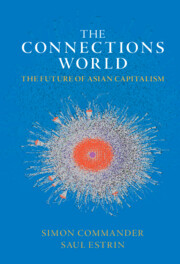Book contents
- The Connections World
- The Connections World
- Copyright page
- Dedication
- Contents
- Figures
- Colour Plates
- Tables
- Acknowledgements
- Abbreviations
- 1 The Strengths and Fallibilities of Asian Capitalism
- 2 To the Foothills of Everest
- 3 The Power of Networks of Connections
- 4 Networks, Connections and Business Organisation
- 5 What Scope for Innovation?
- 6 Employment in the Connections World
- 7 Whither Asia?
- References
- Index
6 - Employment in the Connections World
Published online by Cambridge University Press: 11 October 2022
- The Connections World
- The Connections World
- Copyright page
- Dedication
- Contents
- Figures
- Colour Plates
- Tables
- Acknowledgements
- Abbreviations
- 1 The Strengths and Fallibilities of Asian Capitalism
- 2 To the Foothills of Everest
- 3 The Power of Networks of Connections
- 4 Networks, Connections and Business Organisation
- 5 What Scope for Innovation?
- 6 Employment in the Connections World
- 7 Whither Asia?
- References
- Index
Summary
Asian governments focus on growth but also worry about employment; they need to create many new jobs just to keep employment stable. Moreover, most employment remains in the informal sector. Those jobs are generally fragile, low wage and low productivity. While many of the business groups that figure in the connections world also create productive and well-remunerated jobs, these are limited in number. Boosting formality and, with it, productivity – a clarion call of almost all Asian governments for decades – has largely failed to materialise. Further, the entrenchment of the connections world has also helped ensure that little progress has been made in bringing in more effective responses to employment risk. Neither government nor companies have a strong interest in promoting arms-length methods of dealing with such risk, preferring to rely on discretion. Jobs can be created, and their destruction tempered, as a result of interactions or even haggling between politicians and employers. The bulk of workers found in the informal economy are excluded. And the modernisation of welfare systems – now feasible given the income levels of many Asian countries – remains stalled.
- Type
- Chapter
- Information
- The Connections WorldThe Future of Asian Capitalism, pp. 210 - 245Publisher: Cambridge University PressPrint publication year: 2022

